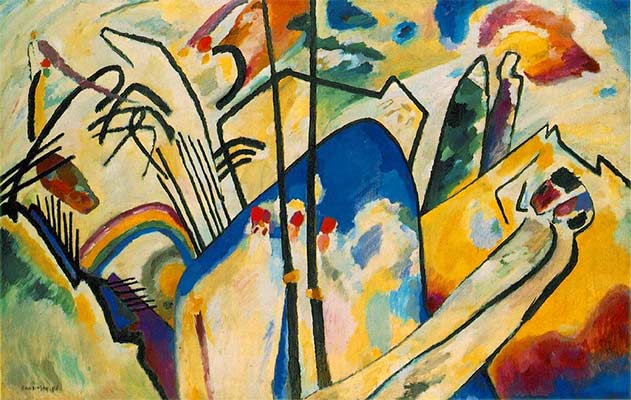Composition IV is an oil on canvas painting by Russian painter Wassily Kandinsky and is a semi-abstract representation of Cossacks in Moscow during the revolutionary period 1905-1906.
It was painted in 1911 and is part of a ten-part collection. Kandinsky used vivid and contrasting colours to make a visual, spiritual and emotional impact on the observer. He is regarded as one of the earliest pioneers in purely abstract art.
Two Cossacks are seen with sabers in the upper left corner of the painting. On the right, are several Cossacks carrying lances and one with a saber against a blue hill with a house on it. A rainbow in the middle left of the picture signifies a bridge. Yellows and reds are outlined by black lines. Kazimir Malevich produced similar themes in his work.
Sharp lines of varying thickness contrast with the softer colours painted, while two vertical lines seem to divide the composition. The viewer is immediately drawn to the area coloured blue, in a background that is largely coloured in light pastels. Colours merge together, and lines and shapes combine, hinting at peace and salvation to follow.
The usage of colour in Monet’s painting Haystacks and the musical composition of Richard Wagner's Lohengrin left quite an impression on Kandinsky. He was also drawn to the spiritual ideas of theosophy of Madame Blavatsky. He used an amalgam of chaotic shapes and colours in Composition IV to convey emotional and spiritual meanings. Human figures did not feature in any in of his art, except in his paintings Sunday, Old Russia (1904) and Riding Couple (1907). The use of colour in both paintings is emphasised over the actual depiction of the subject matter.
From 1906 to 1908 Kandinsky spent much of time travelling across Europe, finally settling in the small Bavarian town of Murnau. Wassily Kandinsky became famous for his painting, Der Blaue Reiter or Blue Rider (1903), which was used to describe his transitional Blue Rider Period, the early phase in his development as a painter. During this period, 1911 to1914, he further explored and refined the use of colour and shape to with emotion that would typify his later works. During this time he helped to establish the Munich New Artists' Association, a home for innovative and experimental artists whose works were too radical for the establishment.
He returned to Russia in 1914 and also helped to establish the Institute of Artistic Culture in Moscow. He left Russia in 1921 after being invited to teach at Bauhaus school of art and architecture by its founder, architect Walter Gropius. from 1922 until the Nazis closed it in 1933.
During the Bauhaus period, (1922–1933), Kandinsky’s paintings took on a geometric aspect, including circles, half-circles, coloured checkerboards, colour and monochrome straight lines, curves, and planes rich in colours and shading, as shown in Yellow – red – blue (1925), all which contribute to the complexity of his compositions. From 1934 to 1944 was the Great Synthesis period. Kandinsky created his last major paintings in his Paris living-room studio. His compositions were now biomorphic, organic in form and outline, as shown in Composition IX (1936) and Composition X (1939).
Kandinsky set the benchmark for expressive contemporary art in the twentieth century. His paintings and writings greatly influenced the Abstract Expressionism movement and its offshoots like Color Field painting. Painters such as Arshile Gorky and Jackson Pollock were influenced by biomorphic work from his later Great Synthesis period. Color Field painters Mark Rothko were fascinated by the Kandinsky’s use of shading and different colours and their impact on the viewer. Even the 1980s artists working in the Neo-Expressionist painters like Julian Schnabel and Philip Guston used his ideas in their own works work.
Wassily Kandinsky was born in Moscow on December 16, 1866, to well educated, upper-class parents of mixed ethnic origins. He lived in France and became a citizen in 1939. He died at Neuilly-sur-Seine in 1944, at age 77. His paintings became more and more abstracted from the surrounding world as he gradually refined his style. He switched to titling his works Composition, Impression, or Improvisation to heighten their disconnection from the real world and Composition IV is an excellent example of this.




